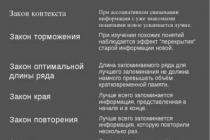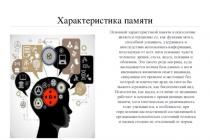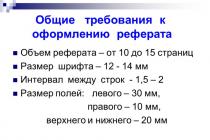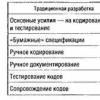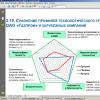Vyacheslav Ivanyuk Ph.D., employee of the representative office of Cable&Wireless,
first published on the site //www.e-xecutive.ru
Promotion of communication services in Russia and abroad are, as they say, two big differences. Russian specificity leaves its mark on any, even the most thoughtful and "doomed to success" marketing company.
Consider on practical example implementation of the classic task of positioning a new service for the company on the related market. It's about the service market. telephone communication.
Let's call our company Operator.
In order to more clearly represent the portrait of the Operator, it must be added that this large company, by the standards of the telecommunications market, was and still is a monopolist in the provision of specialized communication services, for example, the lease of low-speed long-distance communication channels. This type of service will be considered traditional for the Operator. In the field of providing other more common telecommunications services (for example, the Internet, data transmission), the Operator's position is stable, but far from being a leader. In terms of being known as a telephone service provider, the Operator is a newcomer. None of the existing consumers of the company's traditional services, and even more so of firms that are not the Operator's clients, has ever associated it with telephone services.
The Operator's shareholders set a strict condition for the directors of the enterprise - to make the company commercially attractive. The company's management broadcast the task to subordinates - in a short time to do new business for the provision of telephone services profitable. For this, a budget of several hundred thousand dollars was promised, in-house support was guaranteed at all levels.
The development and management of the program was entrusted to the marketing service (hereinafter referred to as SM), which approached the solution of this problem academically. Within a short period of time, a marketing plan was developed, which included full complex activities to promote the operator's services: direct and hidden advertising in the media and industry publications, participation in exhibitions and conferences, direct marketing, targeted marketing campaigns, "promotion" of the Operator on the Internet, telemarketing, fax mailings, etc. The program budget was calculated in such a way as not to exceed 5-7% of the expected annual volume of income from the sale of telephone services. The developed plan, indicating the scope of events, their timing and cost, was approved and signed by the company's management.
The planned amount of funding of several hundred thousand dollars a year seemed sufficient. But, by Moscow standards, for a company planning to make money on new service several million in the telephone market, where no one knows her, the task was more than an easy one.
As intended by the developers marketing program, half of the funds allocated for marketing should have been spent in the first quarter for a large-scale information campaign. The aggressive start was supposed to form a new image of the Operator and provide training client base for the whole calendar year. apogee starting stage The marketing program was supposed to be the Sviaz-Expocom exhibition. Participation in it was a mandatory component of the program in order to demonstrate new opportunities to potential customers, conclude contracts for the provision of telephone services, as well as sign distribution and partnership agreements.
To prevent the Operator's activity from being leveled by advertising and marketing campaigns of other operators spending tens of millions of dollars in total, CM recommended making direct marketing the main tool of the marketing campaign - of course, with mandatory advertising and information support. In this article, these components of the marketing program are not considered.
Having received the approval of the plan, CM began its implementation. The first step was to find a partner who could help develop and then take over the implementation of the direct marketing component of the marketing plan.
Four Moscow agencies specializing in the development and implementation of DM programs were sent offers to participate in the tender. The first of the agencies showed no interest: a lot of work, little money, the client is very demanding. The three remaining agencies responded and shared their vision of the DM events.
In general, the proposed options were similar, with the only difference that one of the agencies offered a scalable solution, taking into account different amounts of funding. In addition, this agency not only submitted a plan for the first stage of the DM campaign for tender, but also substantiated the concept of the DM program, taking into account the specifics of the Operator for the whole year. Positive recommendations from companies that cooperated with this agency before finally determined the choice of the Operator. Let's call the company that won the tender a DM agency.
The marketing service determined for the DM agency main task- to form a portfolio of orders in the amount of at least 40–50 large potential customers. At the same time, it is necessary to change the perception of the Operator in the market, that is, to make its image more modern, to form the image of a provider of integrated communication services with an emphasis on telephony. A secondary goal was also set - to improve the qualifications of the employees of the Operator's commercial department in the amount necessary for successful sales of telephone services.
To solve the set tasks within the established time frame, the DM-agency proposed a 3-month action plan. According to the agency's plan, during this time it is quite realistic to implement two cycles of DM (Fig. 1, 2), consisting of the following iterations: a) preparation of primary information; b) its clarification; c) preparation and sending of a letter of appeal with a return form; d) control contact with the addressee for a reminder; e) receiving a response and taking it into account for further work.

Starting the practical implementation of the starting stage of the DM program, the most important condition was the need to be in time for the Sviaz-Expocom exhibition, scheduled for May. In just over 3 months, it was necessary to carry out all the activities of the starting stage at any cost.
The agency selection tender was completed in mid-January. It took at least one week to clarify the program, its budget and make an advance payment to the DM agency. Due to the fault of the financial department of the Operator, which refused to confirm to the marketing service the amount and procedure of financing previously agreed with them, this period was delayed for a month - until the second half of February.
To collect primary information about potential customers, it was planned to use both open databases (DB) and special ones. Of greatest marketing interest is information about commercial enterprises, construction organizations, business centers, hotels and all other large consumers of telephone services. In addition, the databases of subscribers of commercial telecom operators (Operator's competitors) were of interest. Firms that own such information do not advertise themselves and work personally with each buyer, mainly for cash. The Operator's marketing department had contacts with several such firms. An agreement on the purchase of the desired information was promptly reached for an insignificant amount in relation to the real cost of the information.
For three weeks, the financial department of the Operator refused to allocate the required amount for cash. In the end, we managed to convince the information provider to agree to a cashless payment. As a result, the information was received only by the second week of March.
After receiving the initial information, it was necessary to reduce all the data to a uniform form for further processing. In sub-step 1.2, 7 independent databases were used. Here we must pay tribute to the DM agency, which promptly and accurately processed huge amounts of data. The agency verified matches, intersections of different formats and presentation of data on more than 60 thousand pieces of information, each of which contained from 5 to 20 characteristics. As a result, the DM agency presented a database of 5.5 thousand large companies and cluster addresses potential clients, which contained not only general information, but also the names of persons responsible for providing communications, telephones, faxes, e-mail, the name of an existing telecommunications service provider, territorial proximity to the center of the capital, and other useful information. It should be noted that the total number of companies in the database could be about 20 thousand, but among them only those that spend and/or can spend more than 1–1.5 thousand dollars per month for telephone services were selected by experts.
We add another week and a half to the second week of March, when sub-stage 1.1 was supposed to end, and we get that the database update (sub-stage 1.3) will begin in the last week of March. There is a lot of work behind the concept of “database updating”, starting from the development of an interview, its aerobatics and ending with entering information into the database, evaluating its reliability. In addition, at sub-stage 1.3, the existence of needs for communication services, the degree of satisfaction with the existing telecommunications system, the size of the average monthly costs for telecommunications, the number of employees in the company, the degree of computerization, the attitude towards a possible proposal to change the provider of communication services, a list of key factors that determine the communication service provider from the point of view of each particular respondent, and other important information.
Even if you use the services of a professional Call-center, working through a list of 5.5 thousand companies will take at least two weeks. This time is required for the development of the interview, piloting it, training the operators, programming the electronic form for recording answers to questions, taking into account several possible scenarios, and compiling reports on the results of the interview.
Thus, sub-phase 1.3 should be completed by the second week of April. Only 3 weeks remain to carry out sub-stages 1.4-1.8 of the first cycle and sub-stages 2.1-2.8 of the second cycle of the starting stage. Taking into account the fact that printing and sending letters in the first cycle takes one week, and receiving and processing responses to the return form - at least two weeks, the most important condition for holding a DM campaign - to be in time for the exhibition in May - can be considered unfulfilled!
However, the Operator's CM, together with the DM agency, solved the task on time. How?
The start of the action, as you remember, was given in mid-January. Without waiting for the solution of financial problems between the Operator's services, the DM-Agency started preparing a single database (DB). Several original databases were the property of the DM agency. Two databases were available from the CM Operator. The missing databases had to be purchased from a third-party vendor for cash.
All databases, with the exception of external ones, were brought to a single standard, including rules for writing fields, data formats, etc. To understand the amount of work, you need to know that tens of thousands of records were processed manually. The data amenable to formalization were passed through the optimization algorithm of the DM agency's own development. Small and medium-sized companies were grouped according to their address in order to identify their places of accumulation and to form a list of business centers that are missing open information. Construction firms were evaluated by the level of fame and reliability. By the end of January, a single database was 80% ready.
To complete sub-stage 1.2, it remained to add external data, without which the picture of the market of potential consumers was incomplete. If the information had come in when the finance department had disbursed the funds, the deadline would have been missed. Rescued, as always, the personal initiative of the SM and the mutual understanding found with the information provider. The information was obtained on parole that it will not be used in case of non-payment.
Thus, by the time of payment for external information ( second week of February) the unified database has been fully formed.
Sub-stage 1.3 was also prepared in advance. Without waiting for the completion of the preparation of primary information, the DM-Agency developed and agreed on a script for a telephone interview and an electronic form for recording answers. Simultaneously with the completion of the stage of filling a single database, interviews were conducted on 50 companies. The interview was modified taking into account the qualifications of the respondents, their position, the possibility of interviewing several people in one company, as well as the frequent need for repeated calls as a result of an interrupted interview or the absence of the desired respondent on site.
The Operator's marketing service, in turn, updated information on existing customers of traditional services. The list of thousands of clients was dominated by budget organizations, however, among them it was possible to identify about 500 potential consumers of telephone services that are interesting from a commercial point of view.
Of the 7 databases used with 60 thousand records, a database was formed in the amount of 5.5 thousand companies - according to experts, large consumers of telephone services. These companies were phoned for two weeks by a pre-trained group of telephone operators.
Based on the results of telemarketing, 2.5 thousand companies were selected that most fully answered the questions and showed interest in obtaining additional, new or instead of existing telephone services. The two-fold reduction of the original list was a forced measure due to the budgetary framework of the DM-share.
As soon as the first results of telemarketing began to appear, the DM agency recommended that they begin developing a system to motivate potential customers. To do this, the CM identified significant characteristics of consumer groups in terms of activities, decision-making mechanisms, size of companies, responses to questions about the needs for communication services and other factors.
Of course, in the ideal case, each of the 2.5 thousand companies should have sent a unique letter and questionnaire.
The DM agency recommended dividing the companies into 6 categories. In each of them there were 3 types of respondents: CEO, IT manager, secretary. In the received 18 variants of the respondents, it was necessary to take into account the answers to the questions: 1) “Are you satisfied with existing system telecommunications support? 2) “Do you use the services of a commercial operator (which one)?”; 3) "Are you planning to modernize/expand the existing telecommunications system?".
In general, there were at least 60 options.
Given the budget, the Operator could afford only 3 options for letters and return forms. Going to meet him, the DM agency agreed to develop 18 letter layouts and 3 versions of revocable questionnaires.
It was decided to address the letters to the respondents on behalf of the General Director of the Operator. The texts of letters had to be coordinated with several authorities within the Operator before being sent. At first glance, the most time-consuming process was the development of letters, compiling questionnaires. An entire article could be devoted to this issue. But of the two weeks spent on sub-steps 1.4 and 1.5, a week was spent on agreeing texts. Each instance within the Operator considered it their duty to comment on the text. As a result of "collective" creativity, the letters took on an unusable form. Should be given credit to CEO, who, by his indication, forced this issue and returned the texts to their original laconic form.
By the end of the first week of March, the layouts of letters and questionnaires were ready. The next week was devoted to the production of 2.5 thousand letters, their packaging and delivery. Outsourcing (outsourcing) is a great thing! No marketing service in such short time would not be able not only to manufacture and pack, but even organize production and track the delivery of so many letters.
Sub-step 1.6 was thwarted by the finance department, which at first flatly refused to transfer the authority to purchase envelopes, pack and deliver letters to the agency. The financiers' argument was simple - why would anyone overpay for mailing management when you can do everything yourself: "We will order cheaper envelopes ourselves, we will pack letters and questionnaires ourselves, we will order the delivery ourselves."
The disruption of the implementation of this sub-stage was prevented at the cost of incredible efforts. The situation was saved by the commercial director, who, like no one else, understood that if you independently carry out all the work related to mailing, you will need to write instructions, change people's work schedules, conclude contracts for the purchase of envelopes and mail delivery at a reduced rate, etc. In total, the process would take a month. This would significantly reduce the performance of the action.
The third and fourth weeks of March were devoted to receiving return forms and taking phone calls from potential clients. To do this, SM arranged for her to have an easy-to-remember telephone number and arranged for a trained telephone dispatcher to be on duty. The dispatcher had access to the source database. When a potential client called, the dispatcher clarified the identification number of the received letter, immediately found information about the caller and registered the request in real time.
According to statistics, the average response rate to the first letter of appeal is 2-3%. Such a low efficiency of the action did not suit its organizers. Therefore, it was decided to conduct a reminder call among the companies that did not send questionnaires. Since only 50 questionnaires (2%) were received two weeks after the mailing of the letters, all companies without exception were included in the repeat call list. According to the plan of the DM agency, the call-reminder should be carried out by the sales staff, so that if a potential client is interested, they can immediately give qualified advice and, possibly, move on to selling services.
The second call was scheduled for the first two weeks of April. The marketing service had a preliminary agreement with the personnel department and the director of the sales service on seconding 10 of his employees to the SM for the period of the "action". The DM agency prepared questionnaires in which it was necessary to enter the information received during the telephone conversation information. The questionnaire already contained the name of the company, the surname and position of the person to whom the letter was sent, the results of the respondents' answers to the questions of the first survey. Within two days, the DM-agency, together with the marketing service, conducted training for the Operator's employees. All possible scenarios for the development of a telephone conversation with a potential customer were worked out and discussed, methods of persuading respondents of the Operator's advantages, methods of "promoting" the respondent to the conversation and options for politely exiting the conversation were tested. There seemed to be no signs of failure.
But problems were not long in coming.
When there were only a few days left before the end of the promotion, the Operator's technical service could not resolve the issue of providing 10 telephone lines and apparatuses. Imagine the surprise of everyone, including representatives of the DM agency, who came to conduct telemarketing, when they found only half of the telephones on the spot. Half not in the sense of 5 out of 10 devices, but in the sense - only a block with a disk for dialing. Headsets (or at least ordinary handsets) were not included with the devices. Their "owners" were permanent employees of the client department, and the head of the department flatly refused to give them out for the duration of the call. It took the next two days to install conventional telephone sets. Everything seemed to be over... The technical service of the Operator, the owner of a high-quality digital network, for reasons known only to her, installed MGTS lines with terrifying quality. So that the company's employees had to dial numbers 3-5 times, and when they called, in response to the question "What do you offer?" yelling into the phone: “We offer high-quality digital telephony…”
But technical problems were solvable. "Insoluble" was the human factor. Within hours of field testing, it became clear that worse interviewers than today's sales people could hardly be imagined. This was not manifested in the fact that they spoke badly with the interviewee, no, on the contrary, some of them were quite successful and on the first day they agreed on several business meetings. The problem was the complete lack of personal motivation and unwillingness to work in a team - to obey group rules. Day after day the smoke breaks became longer and longer, and "urgent" matters, at first interrupted for the duration of participation in the action, became more and more important.
For 2 weeks, with the help of 10 "qualified" managers from 2.5 thousand companies, only 600 were able to make repeated calls. A devastating result. No exhortations from the CM and the director of the sales service could not affect the low efficiency of the work of the Operator's employees.
By mid-April - two weeks before the scheduled completion date for the launch phase - three-quarters of potential customers were not covered by a repeat call.
Rescued DM-agency. Within a few days, a team of telephone interviewers was recruited and trained. Although the level of knowledge about telephone services was significantly lower than that of the Operator's employees, in this situation their desire to conscientiously conduct a call was incommensurably higher and more important. In order to minimize losses from unqualified calls, a manager was always on duty in the CM, ready to promptly call back the client, information about which was transmitted by the interviewer.
In the fourth week of April, the SM gave the command to stop the secondary ringing. The involved group of interviewers made about 1000 effective calls. By this time, 150 completed questionnaires had been received by fax and 50 telephone calls had been received from interested customers. The response rate at the end of the first cycle of the launch phase was 8%.
There was practically no time and money left to carry out the second cycle in full. Therefore, it was decided not to make a phone call to all 200 companies that showed interest, but based on the information received, select the 70 most interesting among them and send them letters with enclosed invitations to the exhibition. Each letter was signed by a sales manager and accompanied by a personal offer to meet at the booth at a convenient time for the respondent.
Bearing in mind the long terms of coordinating texts with the Operator's authorities, the DM-Agency developed a letter of invitation to the company's booth at the Svyaz-Expocom exhibition in advance.
70 each selected companies sub-stage 2.4 was carried out to clarify the planned time for visiting the exhibition and agree on the duty schedule of sales managers at the Operator's booth.
The logical conclusion of the second cycle of DM was the work at the exhibition. At the stand, a mandatory record of all visitors was kept, each of them was asked to fill out a questionnaire. Of the 70 invited as a result of the DM campaign, 50 respondents came and filled out a questionnaire in which they indicated their interest: “purchasing communication services from the Operator”. In total, 600 people from 550 companies visited the Operator's booth and filled out questionnaires, of which more than 150 were participants of the DM campaign.
Thus, despite the constantly arising problems, the task of forming a portfolio of orders in the amount of at least 40-50 customers was successfully solved!
Send your good work in the knowledge base is simple. Use the form below
Students, graduate students, young scientists who use the knowledge base in their studies and work will be very grateful to you.
Similar Documents
Advertising in the system of marketing communications. Strategies for promotion of communication services. Mobile advertising in Belarus: trends and prospects. Analysis of the activities of the company SOOO "Mobile TeleSystems". The effectiveness of Bluetooth advertising for the marketing of enterprise services.
term paper, added 12/09/2014
Theoretical approaches to the study and the main types of BTL communications. BTL in the system of marketing communications, analysis of the state of the BTL advertising market in Russia. The concept of banking services and features of their promotion, strategy analysis advertising campaign jar.
thesis, added 06/24/2010
The concept of marketing communications. Elements of marketing communication. Advertising in terms of marketing communications. The idea of a general marketing strategy firms. Types of marketing communication activities.
term paper, added 03/02/2003
Overview of marketing communications, their characteristics in terms of purpose, scope and structure. Functions and promotion plan, its methods. Advertising, sales promotion, personal selling. Service promotion program on the example of the sports and entertainment center "Cairo".
thesis, added 06/15/2012
Evaluation of the effectiveness of marketing communications. Peculiarities marketing promotion in the advertising market. Analysis of internal and external environment"Advertising Online" company. Choice of the most effective tools marketing communications for the company.
thesis, added 06/14/2014
Disclosure of the essence of sales promotion and definition of its role in the complex of marketing communications. Consideration of the goals and methods of promoting goods on the market. Description of the methods of monitoring and evaluating the results of a comprehensive program of sales promotion.
term paper, added 10/11/2010
The role of sales promotion in the system of promotion of goods and services. Advertising and promotion of products on the market. Decision making in the field trademarks, packaging and label as a marketing tool. Product distribution channels and sales promotion.
term paper, added 05/01/2011
The essence of the marketing communication strategy of a tourist enterprise. Personal selling in tourism enterprise marketing. Advertising in the complex of marketing communications. Sales promotion in the complex of marketing communications.
term paper, added 11/01/2002
As you know, the policy of product promotion is implemented through the use of such means of communication as advertising, personal selling, sales promotion, public relations. We note right away that such an element of the complex of communications as a personal sale to promote a product in the form of services cellular communication is of little use and therefore is not used by Velcom. Let's try to determine the degree of use of the remaining elements of the incentive complex.
The main means of communication used by Velcom is, according to the authors of the work, advertising. company in different time used and still used mainly informative and persuasive advertising. One of the many examples of informative advertising is ads services "Favorite number". An example of persuasive advertising is the recent reduction in the cost of on-net calls.
Of the most commonly used means of disseminating information, one should single out advertising in the press, print advertising (brochures, booklets, leaflets, posters, company wall and table calendars, etc.), radio and television advertising, promotional souvenirs (branded packaging materials in the form of folders and etc.), advertising on the Internet, billboards along highways, advertising on transport.
It should also be noted that the company used competitive advertising in relation to Mobile Telesystems LLC in the form billboard with the slogan "Seasonal discounts are melting fast."
When developing advertising budget the method of compliance with the goals and objectives of the company is used. Marketing department as planned promotions and campaigns determines the annual cost of advertising activities. It should also be noted that the company constantly evaluates the effectiveness of advertising activities by conducting various surveys, tests for remembering the trademark.
An equally important element of the communication complex used by Velcom is sales promotion. It is conducted at three levels: consumers, employees of the company, dealers.
At the consumer level, sales are stimulated by providing credit for the purchase of a mobile phone. From October 1, 2003, the rules for granting RRB-Bank loans to Velcom subscribers were changed. Now the down payment for the purchase of a mobile phone is 10% (versus the previous 30%). The annual interest rate has also been reduced and now stands at 32%.
The Bank for Reconversion and Development (RRB-Bank) provides loans for the purchase of goods individuals and private entrepreneurs. Velcom subscribers registered in Minsk and Minsk region can purchase on credit any telephone set that is sold in the operator's offices.
The first 10% of the cost of the selected telephone set is paid at the operator's office. After clearance contractual relations with the bank, the phone becomes the property of the subscriber, and the remaining amount is paid in monthly installments at the cash desk of RRB-Bank.
Also, among the measures to stimulate sales at the consumer level, one can single out a reduction in the cost of on-net calls. Starting October 11, 2003, for all Velcom network subscribers served on the basis of contracts for the provision of telecommunication services under the tariff plans "Start", "Standard" and "Business +", the cost of on-net calls has been reduced by up to 50%.
To be more precise, the cost of the first minute of an intranet conversation has halved. At the same time, the 50% discount, effective from the second minute of the call, has been cancelled. Subscribers who talk mainly within the network and make a large number of calls lasting up to a minute.
Velcom is unlikely to experience a serious decline in ARPU and overall profit, because subconsciously knowing that “calls are half the price”, subscribers start talking much more with the same monthly fee. In addition, the price reduction affected only the first minute of the conversation and only within the network. An indirect confirmation of the increase in the number of conversations could be observed in the increased network load in the center of Minsk immediately after the tariff reduction (periodically occurring “Network Busy”). However, one can hardly expect serious network congestion, as was the case with the rapid growth of the MTS subscriber base - the capacity of the Velcom network in Minsk has been increased thanks to the recently launched base stations of the GSM1800 standard.
Reducing the cost of on-net calls should, first of all, allow Velcom to retain existing low-income subscribers, and, possibly, attract MTS subscribers who are dissatisfied with the quality of communication.
Simultaneously with the reduction in the cost of calls, Velcom announced an "amnesty" for subscribers who are in blocking mode. To resume the provision of services, the subscriber must pay off the debt and pay 20,000 rubles. prepayment. In this case, the reconnection fee, penalty fee and the full amount of the prepayment are not paid.
Within the company itself, employees are rewarded depending on the number of connected corporate clients.
Sales promotion at the level of dealers is carried out through the establishment of differentiated payment rates for connection of each subscriber. Differentiation occurs depending on the number of connected subscribers.
Public relations are a special element of Velcom's communication policy. Communication with the public is carried out through the media through interviews, specially created services within the company, designed to answer all the questions that customers have; through PR campaigns. Among the latest PR campaigns conducted by Velcom are the following:
1. “What are you ready for for a mobile phone?”;
2. "Mobile hunting from Velcom";
4. "Express - good luck";
5. "Velcom - make a wish."
The company does not ignore such a significant social group population as low-income people and people with disabilities. Social program Velcom includes several directions. War veterans, the disabled, combatants in Afghanistan and other categories of citizens who have a state-established right to benefits are served by the company at a reduced rate.
Velcom takes part in charity events, including assistance to the Belarusian Children's Hospice, the Association of Multiple Sclerosis Patients, the construction of the House of Mercy, participation in the annual campaigns of the Women's charitable organization”, as well as support for cultural events, children's and youth sports and tourism in Belarus, the National Olympic Committee of the Republic of Belarus.
The analysis of Velcom's promotion policy shows that the company makes full use of the main elements of the communication complex, namely advertising, sales promotion, and public relations.
1. Section
Theoretical part
1.1. Service characteristics mobile communications
In this course project three companies that offer their mobile communication services will be considered. These are Beeline, MTS, Megafon.
Let's begin to consider the cellular communication "MTS".
Mobile communication "MTS" was formed
in October 1993, OJSC Moscow City Telephone Network (MGTS), Deutsche Telecom (DeTeMobil), Siemens and several other shareholders as a closed joint stock company. four Russian companies owned 53% of the shares, two German companies- 47%. At the end of 1996 AFK Sistema acquired a stake from Russian shareholders, and DeTeMobil bought Siemens shares. On March 1, 2000, as a result of the merger of MTS CJSC and RTK CJSC, Mobile TeleSystems OJSC was formed.
In 2004, she increased her stake in CJSC Far Eastern Cellular Systems - 900 (DVSS-900) and OJSC TAIF-TELCOM to 100%. MTS became the owner of a 100% stake in Primtelefon and CJSC Digital Networks of Udmurtia - 900 (TsSU-900), CJSC Astrakhan Mobile and CJSC Volgograd Mobile.
On July 16, 2004, MTS announced the acquisition of a 74% stake in Uzdunrobita, the largest mobile operator in Uzbekistan.
In Russia, in 2005, MTS increased its share in the following subsidiaries to 100%: Gorizont-RT in Yakutia, in Uraltel, Telesot-Alania, Sibintertelecom, ReCom.
In the same year, MTS began to provide cellular communication services in Kalmykia, the Jewish Autonomous Region, the republics of the North Caucasus - Ingushetia, Karachay-Cherkessia and Kabardino-Balkaria; received a GSM-1800 license in the Chechen Republic.
In 2005, the company significantly expanded its portfolio additional services and was the first among Russian operators to offer subscribers a range of services based on LBS and RBT technologies.
In May 2006, MTS completed the restructuring of the company, within the framework of which the following management levels were created: corporate center, business unit, macro-region, region. The corporate center determines the overall strategy of the company, uniform standards, regulations and management procedures. Business units are responsible for meeting the targets (P&L).
In July 2006, MTS acquired a controlling stake in Dagtelecom LLC, a GSM-900 mobile operator in the Republic of Dagestan.
In June 2007, MTS increased its stake in Uzdunrobita, a subsidiary in Uzbekistan, to 100%.
In September 2007, MTS acquired an 80% stake in leading Armenian operator K-Telekom CJSC (trademark VivaCell) and entered into an auction agreement to buy and sell the remaining 20% stake.
In October 2007, MTS became the first operator in the CIS to launch BlackBerry services. MTS Ukraine subscribers received secure mobile access to corporate mail, applications and the Internet on modern BlackBerry smartphones.
In December 2007, MTS announced the acquisition of 100% of BashCell CJSC (BashCell trademark), a cellular operator in the Republic of Bashkortostan.
Today MTS is the largest mobile operator in Russia, Armenia, Belarus, Ukraine, Uzbekistan, Turkmenistan.
In addition to the mobile operator "MTS", which provides its services on the market, there is another mobile operator - "MegaFon"
The Megafon company began its work in May 2002 as a result of renaming and changing the North-West GSM closed joint-stock company and merging within one trademark with CJSC Sonnik Duo (Moscow), CJSC Mobicom-Caucasus, CJSC Mobicom-Centre, CJSC Mobicom-Novosibirsk, CJSC Mobicom-Khabarovsk, CJSC Mobicom-Kirov, OJSC MSS-Povolzhye, CJSC Volzhsky GSM and CJSC Ural GS EM
IMT-2000/UMTS covers the entire territory of Russia with a population of 142 million people. Also, the Company's subsidiary, TT-Mobile CJSC, provides cellular communication services in Tajikistan.
Megaphone builds its business based on the principles of maximum satisfaction of subscribers' needs, fair competition and information openness.
Company uses advanced technologies that open up new opportunities for subscribers to communicate and work with information. The range of high-quality mobile communication services, unique for the Russian telecommunications market, is addressed to both the mass consumer and corporate clients.
MegaFon intends to realize the advantages of the all-Russian network with maximum effect: uniform principles for charging services, the use of uniform technological platforms, a single set of additional services and products available to subscribers in all regions, as well as uniform service standards; provides a wide range of quality services, adhering to advanced service standards; flexible and transparent tariff policy MegaFon allows you to take into account the needs of all groups of subscribers and quickly respond to their changes. Subscribers of the Moscow and St. Petersburg networks actively use a range of non-voice services based on STK (SIM Tool Kit), LSB (Location Based Services) and MMS (Multimedia Services). The experience gained in the development and implementation of new services in the Moscow and Northwest markets will be used in other regions as well.
Today, the mobile operator Megafon covers 78 regions of Russia. The company will strive to improve services and develop new tariffs.
An important competitor for MTS and MegaFon is the mobile operator Bee Line.
Cellular operator Bee Line began to provide its services on the market since 1992. Bee Line began its work with the fact that the working group was developing a project for a cellular communication network. A switchboard and a base station are being installed on the building of the Ministry of Foreign Affairs in Moscow. Russia's first experimental network of the AMPS standard with a capacity of 200 subscribers is starting to work. Checking the connection, that is, a test call was made on July 12 of the same year. At the first meeting of shareholders of JSC VimpelCom, Dmitry Zimin, the founder of the company, is approved for the position of General Designer. The company has been providing its services for over 15 years. In 2008, the company promotes its service - wireless Internet. In addition to providing new services, the company also provides assistance to the poor. The program developed by the company is called "Bright Childhood".
As part of this program, Bee Line will equip and renovate children's playgrounds. To date, sites have been installed in Tomsk, Kirov, Ivanovo, and Kaluga.
The company not only deals with the placement of playgrounds for children, but also thought about the children who live in remote and rural schools 56 Russian regions. Such a program was launched in 2004 under the auspices of the Ministry of Education and Science of the Russian Federation.
There is competition between these companies on the market, but consumers prefer Bee Line cellular communication more. Each company has its own logo, which can be used to determine which mobile operator provides its services to the market.
Bee Line company logo.
![]()
Megafon company logo

MTS company logo
1.2 Competitiveness of mobile services
Previously, Bee Line had a different logo, it was a bee, but then the Beeline management decided to make a different logo, also giving information that you need to live on the bright side.
The main factors of competitiveness of mobile communication networks are:
Network coverage area
National international roaming
Service quality
Tariff policy
Sales promotion
Dealer networks
In order to remain competitive, the main efforts
operators aim at expanding the boundaries of the market, attracting consumers, creating an effective system for promoting services, i.e., focusing on operational marketing. In addition to marketing factors, such as a flexible tariff policy, a range of additional services, effective advertising and PR,
various methods of sales promotion, creation of dealer networks, the most important factors in the competitiveness of operator companies
is the availability of national and international roaming, the size of the network coverage area, the reliability of the quality of the communication services provided.
Based on these factors, operators use methods
competition, which can be conditionally divided into price and
non-price
Methods of competition between operators
Non-price Price
Access to regional - reduction of base
Tariff markets
Provision of roaming - variety
Expanding the range of tariff plans
Payment for services
Improving the quality of services - providing discounts
Price competition is one of the most effective means
market rivalry. If in 1991-1992 the minimum contract price was about $6,000, then by mid-1994 it dropped to $400-1,500, and then, after the 1998 crisis, fell almost to cost. The trend towards constant reduction of tariffs is observed today. A vivid example of this is the tariff plans "Extra Jeans" (MTS) and "Boom" (Beeline GSM). The structure of payments for mobile communication services includes: price for a cell phone, advance payment, monthly subscription fee and cost of a minute of conversation. Price competition involves operating with the values of precisely these four kinds payments.
For example, when connecting to an operator, the subscriber receives a discount on the purchase of a phone, while the amount of the discount depends on the operator to which the connection is made. In another example, the entire amount for a network connection is transferred as an upfront payment. As for the cost of a minute of conversation, this option is possible - every second
minute free. There may be no subscription fee per month, but if payment cards have an expiration date, then this can be considered a hidden subscription fee.
The most widely used are a variety of tariff plans, which are specifically composed service packages focused on various segments of the consumer market: the business sector, families with an average income, youth, etc.
Various methods of payment for communication services are also related to price competition. To date, the most widespread are non-cash payments, cash payments at the office of the company or individual authorized banks, payment by credit cards,
the use of express payment cards, etc. In addition, such "frontier" methods of price and non-price competition are used as: discounts from the price of the phone; minutes of conversation when calling within the network; extending the validity of plastic cards while reducing tariffs; per-second billing, etc. In contrast to the price range of non-price methods of competition in the mobile communications market is much wider.
The current pace of the spread of mobile communications in Russia is determined not only by development in the Moscow and St. Petersburg regions, but also by access to regional markets (including the market
Rostov region), the potential growth of which is higher than in Moscow.
Over the past year alone, the share of regions has grown from 38 to 47%, but, nevertheless, the lag in the development of regions in relation to Moscow is about two years. In addition, the regional development of mobile networks
noticeably slows down the technical imperfection of the existing infrastructure of the public network.
An integral part of the service package of most operators
mobile communication is to provide services of national and international level. This technical possibility provides today the mobility of Russian subscribers practically throughout the country and abroad.
Expanding the range of additional services is an important
a component of increasing the competitiveness of mobile operators. These services include: direct dialing, voicemail, call forwarding, three-way communication,
automatic number identification (or prohibition of number identification),
messaging (SMS, MMS, EMS), WAP, GPRS, etc. In order to gain advantages in a competitive position in the cellular communication market and additional income, operator companies are ready to invest significant investments in the development of new technologies and in
introduction of fundamentally new multimedia and high-speed services of the third generation of mobile communication systems.
competitive struggle. With the force of competition, the scale and, accordingly, the costs of advertising activities of operators have increased: to traditional means (radio, TV, periodicals, outdoor
discounts and the nearest plans of the company.
Another competitive factor is the quality of services. Naturally, the transmitted information, except for spatial displacement, should not undergo any other
changes, as this leads to the loss of its consumer properties and value. This results in increased requirements for the quality of services.
communication and confidentiality.
1.3 Marketing of mobile services in Russia
The company has been providing mobile communication services since 1992.
Cellular mobile communication systems are usually divided into several generations. The first generation refers to analog systems operating, as a rule, within national borders. Digital systems covering individual regions of the globe constitute a class of second generation systems. Third generation systems are future universal digital systems operating on a global scale and providing consumers with a wide range of modern services.
The present period is characterized by the ubiquity of second generation systems, the gradual phasing out of first generation systems and the creation of the first fragments of third generation networks. For example, in the countries of Western Europe, along with a significant annual increase in the number of subscribers of digital GSM networks, there is a noticeable decrease in the number of subscribers of analog networks.
Currently in Russia there are federal networks GSM and NMT-450 cellular mobile communications, as well as regional AMPS/DAMPS networks. These networks are an integral part of the interconnected communication network (VSN) of the Russian Federation and interact with the public telephone network. A characteristic feature of mobile communications in Russia is a significant concentration of subscribers in the Moscow and Leningrad regions (Moscow, St. Petersburg and their regions); their number reaches 68% of the total number of Russian subscribers with a penetration rate of more than 5%. There is a trend of consolidation of networks of operators.
Operators of large, high-yield networks have a greater opportunity to expand their subscriber base through the introduction, along with a set of basic services a number of new services and applications, including access to the Internet via cellular networks, etc. Subscribers were connected on a prepaid basis, mobile network services began to be provided in the subway, the prototype for the implementation of third-generation networks was the introduction of WAP-access services to the Internet directly from the subscriber's mobile terminal. The active development of mobile networks has become possible with national and international roaming.
The liberalization of most national telecommunications markets, which made competition in these markets possible, as well as the explosive nature of the development of Internet access services, have led to a sharp increase in the amount of data circulating in global networks and forced operators to reconsider the basis of their development strategy in relation to transmission systems. In 1999, there were 200 million Internet users in the world; by 2003 the projected figure will increase to 600 million people.
The two factors mentioned above combined to give rise to a new phenomenon, the convergence of networks and services. Convergence is a multi-valued concept. It implies the merger of many different networks - the public telephone network, data networks, broadcasting and television distribution networks, the Internet and corporate networks - and many different services, including communication services and information services in arbitrary combinations in the form of multimedia . There are trends in the integration of cellular mobile services, paging (based on SMS services) and trunked radio communications.
In Russia, the process of convergence should primarily affect large operator companies that will be able to introduce packet-switched information transmission on their networks. This will enable users to provide many value-added services and applications that are not available to operators with a traditional circuit-switched infrastructure.
The introduction of packet switching in cellular mobile networks will contribute to the development of so-called vertical markets in Russia. In "vertical markets" the following services may be in demand:
ATM service;
maintenance of points of sale of goods and services;
serving the needs of public utilities;
remote monitoring of various industrial sensors;
transportation control;
ensuring security functions;
ensuring the operational needs of law enforcement agencies, services emergency assistance, emergency services.
In the future, with the commissioning of third-generation systems, equipment manufacturers will launch personal multimedia communicators on the market, which will make it possible to use the information and communication resources of the Internet in full and thereby make the process of convergence of networks and services real for the end user.
In this market, the best provider of its services is the Bee Line company, because its services are aimed at a simple buyer with a small income. On the company's website, we can find the information that we need, that is, such information: how to connect the Internet, they will also tell everyone about new services and their cost.
2. Section
Practical part
2.1 Marketing research plan
Stage 1. goal setting
The main goal of the study. Assessment of the competitiveness of mobile communication services.
Stage 2. Setting goals
1 the task is to select the attributes on the basis of which the comparison will be carried out
2 the task is to identify the most significant among the attributes that determine the competitive position of the service in the eyes of consumers
3 the task is to identify the positions of the services of various competitors
4 the task is to evaluate the product according to the integral indicator of competitiveness
5 the task is to give a comparative assessment of the effectiveness of competitors' products.
Stage 3. Formulation of a working hypothesis
The studied service is competitive in the compared class of goods.
Stage 4. Determining the source of information
The source of information is the Internet.
Stage 5 Methods for collecting primary information
Observation, survey, questionnaires
Stage 6 Methods for processing and analyzing the information received
Questionnaire survey data is processed manually, and the competitiveness assessment is determined using an integral indicator
Stage 7. Programmed result
As a result of the study, conclusions should be drawn about the advantages and disadvantages of the evaluated products. Comparison with analogues, as well as proposals for measures to be taken to improve its position in the market.
Stage 9 Place and time of marketing research
Expert list
According to this survey, ten attributes were selected
Attributes:
Service quality
Fast service
contact
The number of employees
The combination of price and quality
Work experience
Discount for regular customers
A set of promoted services
It was proposed to 5 experts to evaluate the attributes on a ten-point scale
Experts:
Chekmareva A.
Nazarkina I.
Vinokurov D.
Bulanov R.
Table 2.1
|
Attributes |
importance scale |
very important |
||||||||||
|
service quality |
||||||||||||
|
speed of service |
||||||||||||
|
contact |
||||||||||||
|
number of employees |
||||||||||||
|
combination of price and quality |
||||||||||||
|
work experience of employees |
||||||||||||
|
discount for regular customers |
||||||||||||
|
complex of advanced services |
||||||||||||
|
attentiveness of the staff |
Development of a competitive strategy on market operators cellular connectionsCoursework >> ManagementForming this ballroom assessment. Analysis estimates the full attractiveness of the industry ... interested in having a choice on market cellular connections. On this moment there are 3 large... and competitiveness it is necessary to actively stimulate the growth of demand on additional... Pricing on services cellular connectionsAbstract >> EconomicsThird and next generations connections. For modern market cellular connections characterized by a transition from providing ... segmentation market Preservation and enhancement competitiveness Operators Penetration on new consumer markets connections Grade costs... Competitiveness cellular phonesAbstract >> Culture and artIn combination with environmental self-control. IN connections with this important task is perfection... and the dynamism of events on market and their consequences. 3 Grade competitiveness on example cellular phones presented on market city of Ussuriysk. ... Competitiveness firms in the strategic management systemCoursework >> Management... competitiveness firm "Mobicom - Caucasus" operating on North Caucasus under the trademark "Megaphone" on market cellular connections... For estimates possible reactions and strategic potential of competitors. Implementation of such an analysis connected with processing... | |||||||||||
Telecommunication technologies are an important aspect of everyone's life. modern man. They satisfy our needs for information, communication, and contribute to the development of society as a whole.
Every year, new companies appear on the mobile communications market that offer their services. And thanks to their ingenuity and well-constructed development strategy, they manage to recapture some of the customers from more eminent competitors.
In your strategypromotion of mobile services, companies operate according to a certain scheme. Initially, as a rule, marketing research is carried out in order to find out what exactly potential customers lack.
Then a package of unique services is developed that is more profitable and more interesting for the client, and this can be communication quality or a more attractive price, or maybe convenient communication conditions in roaming or Mobile Internet. In any case, interesting novelties always attract the interest of the consumer.
Due to market saturation and tight competition for the attention of the client, the latter falls great amount all kinds of advertising. And in this case, you just can not do without it. For building advertising company Vpromotion of mobile services There is a huge list of possibilities. Internet advertising will help to attract a large number of customers, as it assumes the scale of the whole country, and is a new promising direction. At the same time, it is financially more profitable for the customer than a commercial on central television. In addition, the creation of a website with a list of services and tariff plans with detailed description is not an unimportant aspect. Not so long ago, some large companies made it possible for their customers, by registering on the site, to view their expenses by phone number and get a printout of calls. Previously, this could be done by coming to the office and writing an application, while this service paid in most cases.
The mass use of mobile communications allows the use of any direction of advertising (everyone uses a mobile phone: from schoolchildren to pensioners, and financial well-being does not play important role). Advertising in public transport, in stores, on the radio, flyers in mailboxes, a man in a mobile phone suit with business cards and brochures. Here everything is limited only by the imagination of the customer and the budget of the advertising company.
Everyone remembers the action from the Megafon company - "collect points", which later could be exchanged for valuable prizes (starting from a mug and a T-shirt with a logo, ending with a mobile phone and a laptop). This action left a good impression on the company's customers, and also helped to attract new ones.
Collaboration with other companies is not a mandatory, but a promising marketing move. Example. Big sales company mobile devices and accessories Euroset signed an agreement with largest company"MTS". When buying a mobile phone in Euroset, the buyer receives a free package of cellular services from MTS with funds on the balance sheet and already with ready-made settings.
Sales policy. It includes the study of demand, active work with clients and the definition of distribution channels. The most important thing is to ensure accessibility. That is, the client has watched a well-designed bright advertisement with new features and, having decided to purchase a package of services, he must easily find an office or branch. Where can I get advice from an attentive worker and help in choosing tariff plan. Today, points for the sale of SIM-cards can be found in city communication centers, in some magazine kiosks on the street, in large supermarkets they separately place a counter with an employee of a particular company, etc. As for the replenishment of the balance, we meet payment terminals everywhere: on the street, in stores, post offices, universities, etc.
More interesting background information about mobile phones, cameras, MP3 players and other digital equipment

